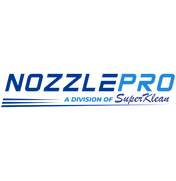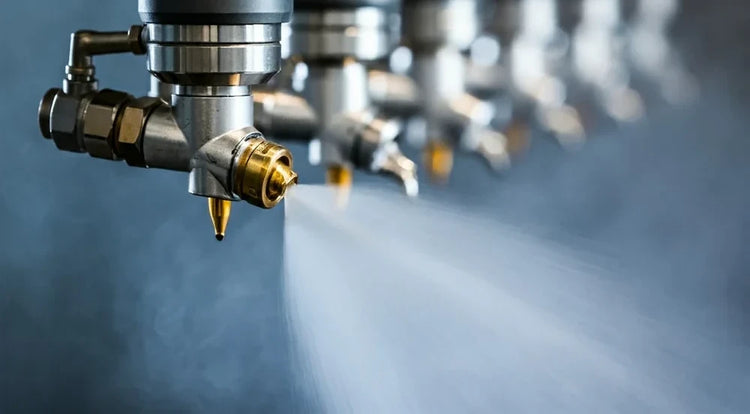Spray Nozzle Resources Hub
Comprehensive technical documentation, selection tools, industry insights, and expert support for spray nozzle applications—helping engineers, maintenance teams, and procurement professionals optimize spray performance across manufacturing, industrial cleaning, agriculture, and specialized applications.
Welcome to NozzlePro's complete resource center for spray technology. Access data sheets, technical specifications, installation guides, flow calculators, troubleshooting tools, and industry expertise to solve your most challenging spray application problems and improve operational efficiency.
Technical Documents & Specifications
Access comprehensive technical documentation covering product specifications, performance data, material compatibility, and engineering details for all NozzlePro spray nozzles and systems.
Product Data Sheets
Detailed specifications including flow rates, spray patterns, pressure ratings, materials, dimensions, and performance curves for every nozzle type.
- Complete dimensional drawings with tolerances
- Flow rate tables by pressure and orifice size
- Spray angle and coverage data
- Material compatibility charts
- Performance curves and graphs
Installation Guides
Step-by-step installation instructions with torque specifications, thread sealant recommendations, mounting orientation, and system integration guidelines.
- Thread compatibility and connection types
- Proper mounting orientation and spacing
- Torque specifications and assembly procedures
- System piping and pressure drop calculations
- Electrical connections for automated systems
Maintenance Manuals
Preventive maintenance schedules, cleaning procedures, wear inspection criteria, troubleshooting guides, and spare parts identification.
- Daily, weekly, and monthly maintenance checklists
- Cleaning and unclogging procedures
- Wear measurement and replacement criteria
- Common problems and solutions
- Spare parts catalogs with ordering information
Technical Specifications
Engineering specifications including pressure ratings, temperature limits, chemical resistance, flow coefficients, and compliance certifications.
- Maximum operating pressure and temperature
- Chemical compatibility for 100+ fluids
- Material certifications and compliance
- Flow coefficient (Cv) values
- Industry standard certifications
CAD Models & Drawings
3D CAD models in multiple formats (STEP, IGES, STL) and 2D engineering drawings for integration into your system designs and documentation.
- 3D models: STEP, IGES, STL, Solidworks
- 2D drawings: DWG, DXF, PDF formats
- Complete assembly models available
- Custom mounting bracket designs
- System layout assistance
Material Certifications
Material test reports, FDA compliance documentation, 3.1 certifications, REACH compliance, and industry-specific material approvals.
- Material test reports and certificates
- FDA food contact compliance
- EN 10204 3.1 certifications available
- REACH and RoHS compliance
- NSF and other industry certifications
Engineering Tools & Calculators
Use our precision engineering tools to size nozzles, calculate flow rates, determine coverage patterns, estimate water consumption, and optimize spray system performance.
Flow Rate Calculator
Calculate precise flow rates based on nozzle orifice size, operating pressure, and fluid properties. Supports water and custom fluids with viscosity correction.
Nozzle Spacing Calculator
Determine optimal nozzle spacing for uniform coverage on conveyor lines, spray bars, and tank washing applications based on spray angle and mounting height.
Coverage Pattern Tool
Visualize spray coverage patterns for flat fan, full cone, and hollow cone nozzles at different mounting heights and pressures.
Pressure Drop Calculator
Calculate pressure drop through nozzles, pipes, fittings, and filters to ensure adequate pressure at spray points and proper pump sizing.
Water Consumption Estimator
Estimate total water usage, operating costs, and potential savings from optimized nozzle selection for your specific application.
Spray System Designer
Interactive tool to design complete spray systems including nozzle selection, pump sizing, tank capacity, and control system recommendations.
Application Guides & Best Practices
Learn industry best practices and application-specific techniques for optimizing spray performance in cooling, coating, cleaning, dust suppression, and specialized industrial processes.
Cooling & Quenching Guide
Optimize heat transfer efficiency, prevent thermal shock, and achieve uniform cooling rates in metal processing, manufacturing, and industrial applications.
Coating & Finishing Guide
Achieve consistent film thickness, minimize overspray, and optimize transfer efficiency for liquid coatings, lubricants, and release agents.
Cleaning & Washing Guide
Select proper spray patterns, pressures, and chemical concentrations for effective cleaning in food processing, industrial maintenance, and sanitation.
Dust Suppression Guide
Control airborne particulates, improve workplace safety, and meet environmental regulations with optimized fog and misting spray systems.
Food Processing Guide
Meet FDA, USDA, and sanitary design standards while optimizing spray performance for food coating, cooling, washing, and sanitation applications.
Agriculture & Irrigation Guide
Maximize water efficiency, ensure uniform crop coverage, and optimize fertilizer application with precision agricultural spray nozzles.
Industry Insights & Knowledge Base
Stay current with the latest spray technology innovations, industry trends, regulatory updates, and application best practices from NozzlePro's engineering team and industry partners.
Technical Blog Articles
In-depth technical articles covering spray nozzle selection, troubleshooting, performance optimization, new product introductions, and application case studies.
- Nozzle selection and sizing tutorials
- Application case studies and success stories
- Troubleshooting common spray problems
- New product announcements and features
- Industry best practices and techniques
Industry Reports & Research
Market analysis, technology trends, regulatory updates, and industry research reports to help you make informed decisions about spray technology investments.
- Market trends and technology forecasts
- Regulatory compliance updates
- Energy efficiency and sustainability reports
- Competitive analysis and benchmarking
- ROI calculators and cost analysis tools
Video Tutorials & Webinars
Watch installation demonstrations, maintenance procedures, troubleshooting guides, and application training videos from NozzlePro's technical experts.
- Product installation video demonstrations
- Maintenance and cleaning tutorials
- Application-specific training webinars
- Troubleshooting and repair guides
- Industry expert interviews and panels
White Papers & Technical Studies
Detailed technical white papers covering spray physics, fluid dynamics, atomization theory, and advanced application engineering topics.
- Spray pattern physics and fluid dynamics
- Atomization and droplet size analysis
- Energy efficiency optimization studies
- Material compatibility research
- Performance testing methodologies
Frequently Asked Questions
Find quick answers to the most common questions about spray nozzle selection, installation, maintenance, troubleshooting, and technical specifications.
How do I select the right spray nozzle for my application?
Nozzle selection depends on six key factors: required flow rate, operating pressure, desired spray pattern (flat fan, full cone, hollow cone), coverage area, fluid properties, and environmental conditions. Start by determining your flow rate and pressure requirements, then select a spray pattern that provides optimal coverage for your application geometry. Consider factors like chemical compatibility, temperature, and required droplet size. Our engineering team can help you select the optimal nozzle—contact us for personalized assistance.
What causes uneven spray patterns and how can I fix them?
Uneven spray patterns typically result from: (1) partial nozzle clogging from debris or scale buildup, (2) wear-related orifice enlargement or deformation, (3) incorrect mounting angle or positioning, (4) pressure fluctuations in the supply line, or (5) incompatible fluid viscosity. Solutions include: installing inline filtration, establishing regular cleaning schedules, replacing worn nozzles when orifice increases 10%, verifying proper mounting orientation, stabilizing supply pressure with accumulator tanks, and selecting nozzles designed for your fluid viscosity range.
How often should spray nozzles be replaced?
Replacement frequency depends on operating conditions, fluid characteristics, and nozzle material. In clean water applications, stainless steel nozzles typically last 2,000–5,000 hours, while tungsten carbide nozzles can exceed 20,000 hours. Abrasive fluids, high pressures, and corrosive chemicals accelerate wear significantly. Replace nozzles when: (1) orifice diameter increases 10% from original size, (2) spray pattern becomes visibly distorted, (3) flow rate increases significantly at constant pressure, or (4) performance no longer meets application requirements. Implement regular inspection intervals and flow testing to determine optimal replacement timing.
What spray nozzle material should I use for my application?
Material selection depends on fluid chemistry, operating pressure/temperature, and abrasiveness. Stainless steel 303/304 works for most water-based applications up to 500 bar. Use hardened stainless (17-4 PH) for high-pressure or mildly abrasive conditions. Tungsten carbide provides maximum wear resistance in severe abrasion or ultra-high pressure applications. Ceramic offers excellent chemical resistance for acids and corrosive fluids. Brass is suitable only for low-pressure residential applications. For food processing, specify FDA-compliant 316L stainless steel. For specific chemical compatibility, consult our material compatibility chart or contact our engineering team.
How do I prevent nozzle clogging in my spray system?
Prevent clogging through: (1) installing inline filtration with mesh size smaller than nozzle orifice (recommend 80% of orifice diameter), (2) implementing water treatment to prevent scale buildup in hard water applications, (3) establishing regular cleaning schedules using ultrasonic cleaning or appropriate chemical cleaners, (4) selecting larger orifice sizes when possible while maintaining required spray characteristics, (5) using self-cleaning nozzle designs for highly contaminated fluids, and (6) installing flush-out systems for automatic cleaning cycles. For persistent clogging issues, consider switching to air atomizing or siphon nozzles less prone to plugging.
Can I use spray nozzles with chemicals and harsh fluids?
Yes, but material compatibility is critical. Stainless steel 316/316L resists most acids, alkalis, and solvents. PTFE (Teflon) and PVDF offer superior chemical resistance for aggressive chemicals. Hastelloy C-276 handles the most corrosive environments including strong acids and oxidizers. Always verify chemical compatibility using our material compatibility charts or contact our engineering team. Consider: (1) chemical concentration and temperature, (2) exposure duration, (3) potential galvanic corrosion with dissimilar metals in system, (4) seal and O-ring material compatibility (EPDM, Viton, Kalrez), and (5) long-term effects on spray performance. We can provide material test data and certifications for critical applications.
Can't Find Your Answer?
Our technical support team is available to answer your specific questions about nozzle selection, installation, troubleshooting, and application optimization. Contact us for expert assistance.
Training & Educational Resources
Expand your spray technology knowledge with comprehensive training programs, certification courses, and educational materials designed for engineers, technicians, and maintenance professionals.
Online Training Courses
Self-paced online courses covering spray nozzle fundamentals, application design, troubleshooting, and advanced topics with completion certificates.
- Spray Nozzle Fundamentals (2 hours)
- Nozzle Selection & Sizing (3 hours)
- Spray System Design (4 hours)
- Maintenance Best Practices (2 hours)
- Advanced Application Engineering (6 hours)
Live Webinars & Workshops
Interactive webinars and hands-on workshops led by industry experts covering current topics, new technologies, and application-specific techniques.
- Monthly technical webinars (1 hour)
- Quarterly application workshops (half-day)
- Annual spray technology conference
- Custom on-site training available
- Q&A sessions with engineers
Educational Materials
Comprehensive reference materials including spray technology handbooks, quick reference guides, glossaries, and technical terminology resources.
- Spray Technology Handbook (PDF)
- Quick Reference Guides by Application
- Technical Terminology Glossary
- Conversion Tables & Formulas
- Industry Standards Reference
Expert Support Services
Access personalized engineering support, application assistance, and technical consulting to optimize spray performance and solve complex application challenges.
Application Engineering Support
Our experienced application engineers provide personalized assistance with nozzle selection, system design, performance optimization, and troubleshooting for your specific requirements.
- Free initial application consultation
- Custom nozzle selection recommendations
- Spray system design and layout assistance
- Performance calculations and modeling
- On-site application testing and evaluation
- Troubleshooting and optimization support
Technical Support Hotline
Direct access to our technical support team for immediate assistance with product questions, installation guidance, troubleshooting, and emergency support.
- Phone: (650) 375-7002
- Email: support@nozzle-pro.com
- Response time: Within 4 business hours
- Emergency support available
- Remote diagnostics and assistance
- Warranty and returns support
Need Personalized Assistance?
Our team of spray technology experts is ready to help you find the right resources, answer your technical questions, and provide customized solutions for your specific application requirements.


Stay Connected
Follow NozzlePro on social media for product updates, technical tips, industry news, application videos, and exclusive content from our engineering team.